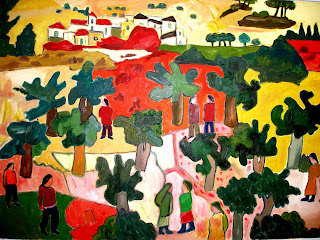
Kevin Newark "Protoplasm"
The
Pavillion Private View 18.00
Up
until Gary speaking about the
Pavillion Gallery I didn't even know it existed as an artist studying in Leeds I think that it
important to know where all the galleries are and to keep
up to date with what exhibitions are being shown there. After an adventure trying to find the gallery we eventually arrived. The gallery
similar to smaller galleries in Berlin with concrete floors and small white walls was exhibiting Kevin
Newarks "Protoplasm". This photographer I became particularly interested in during the reading week in which I was studying digital photography and therefore researching photographers. I came across his work in the "portfolio" magazine, where Newark had won British
Photography award. His work
particularly intrigues me and draws the audience into what
initially appears as a beautiful abstraction but on closer inspection reveals an unsettling interruption into our environment. The photographs are actually carrier bags resting on a canal, however they look almost like x-rays exaggerating the transparency of the plastic becoming almost unrecognizable and not to dis-
similar to astronomy photographs. I spoke to the artist about is work and particularly the lens' he used on the camera as i was trying to create
similar scientific type work in my elective. I also asked him why he had displayed them as he had and had he thought about using light boxes to exaggerate the
luminosity of the images in which he said he hadn't but perhaps that would be a
possibility for other exhibitions. The exhibition was again friendly and welcoming, the curator was
particularly interesting and invited us to critiques where various artists,
curators and writers from
Leeds get together and discuss practices. I
definitely will take this opportunity to mix with a variety of groups within
Leeds to develop and learn from them. This exhibition was particularly interesting for many reasons, for finding a new gallery, for speaking to the artist and the curator and especially for being invited to the critiques.

Chorus
Leeds Grand Theatre Opera House
"To celebrate the opening of the Historic Howard Assembly Room after 30 years of public closure, Opera North projects have asked United Visual Artists to make artwork responding to the newly restored space. This new work is called "Chorus". Press Release.
The installation consists of eight moving pendulums suspended from the ceiling, each one individually generating light and sound, an individual voice that can be heard and followed when moving through the paths. In which there are 3 distinct phases each constructing a different mood within the space. This has been created in collaboration with the composer Mira Calix who recorded individual members of the Opera North Company and instruments to re-create a "chorus" of sound. The power of the pendulums create an almost performance piece which is both an immersive experience for an audience as well as participated. The pendulums transform into something mesmerizing and hypnotic forcing the audience to look at them and how there attached as they swing above and across the breadth of the hall emphasizing the space perhaps instigating a sense of insignificance to the audience. Whilst the randomness of the light and sound portrays a sense of unexpectedness.









